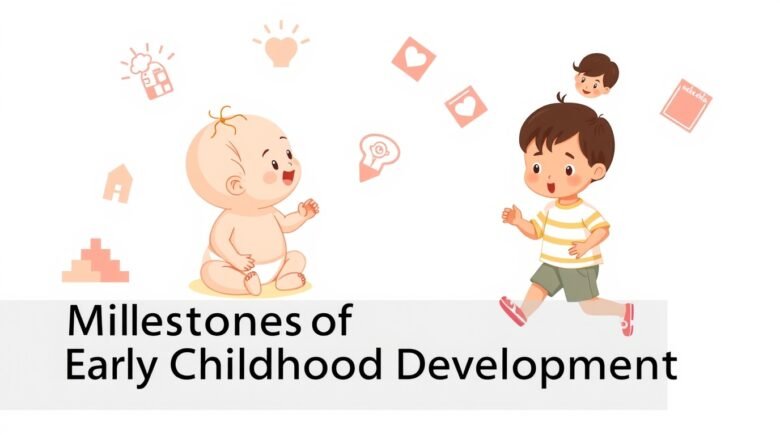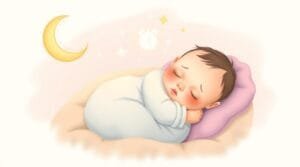Understanding Early Childhood Development
Early childhood development refers to the critical period in a child’s life from birth to age five, which plays a pivotal role in shaping their overall growth, learning capabilities, and health outcomes. This stage is marked by rapid physical, cognitive, emotional, and social advancements. The milestones of early childhood development serve as important indicators of whether children are progressing at a typical rate for their age.
This developmental phase is characterized by significant changes. During the first few years, children learn to communicate, walk, interact with others, and develop their identities. These early experiences are essential for establishing the groundwork for more complex skills required later in life, such as reasoning, decision-making, and emotional regulation. The significance of early childhood development lies not only in these immediate achievements but also in how they influence a child’s long-term well-being and success.
Recognizing and understanding developmental milestones is crucial for caregivers and educators alike. By being aware of these key achievements, they can monitor a child’s growth and identify any potential challenges early on. For example, milestones in early childhood development include skills such as sitting up, first words, or forming simple sentences. Each milestone met indicates that the child is on track, while delays may warrant further observation or intervention. This proactive approach allows for tailored strategies that support the individual needs of each child, ultimately promoting healthy development.
In summary, understanding the milestones of early childhood development enhances our ability to foster environments that encourage learning and growth. This knowledge not only informs parents and educators but also emphasizes the importance of collaboration in nurturing the potential of every child during these formative years.
The Stages of Early Childhood Development
Early childhood development encompasses several critical stages that play a vital role in shaping a child’s growth and future potential. Understanding the milestones of early childhood development across various age brackets helps caregivers and educators support children effectively. The primary stages include infancy, toddlerhood, and early preschool, each marked by distinct characteristics in physical, cognitive, social, and emotional development.
Infancy, covering the age range from birth to one year, is a period of rapid physical growth and sensory development. During this stage, infants typically gain weight and height significantly, demonstrating increased muscle strength and coordination. Cognitive development is reflected in their ability to recognize faces, objects, and sounds, beginning to understand their environment through exploration. Socially, infants form attachments to their caregivers, exhibiting behaviors such as smiling, cooing, and crying, which express their needs and emotions. Emotionally, infants experience a range of feelings, such as joy or frustration, laying the groundwork for future emotional regulation.
The next stage, toddlerhood, spans ages one to three years. This period is characterized by growing independence and exploration. Toddlers typically learn to walk, run, and climb, demonstrating improved motor skills and coordination. Cognitively, they begin to engage in symbolic play, recognizing that objects can represent other things. Social development in toddlers includes parallel play, where children play alongside one another without direct interaction, fostering basic social skills. Emotionally, toddlers experience a wide range of feelings and often struggle with sharing or taking turns, leading to an important learning phase regarding empathy and understanding others’ emotions.
Finally, the early preschool stage, from ages three to five years, marks significant growth in language and social skills. Children in this age group often start using complex sentences and vocabulary, and engage in cooperative play. Cognitive milestones include counting, recognizing letters, and beginning to understand basic concepts. Socially, friendships begin to form, and children learn to navigate group dynamics. Emotionally, preschoolers become more aware of their feelings and those of others, setting the stage for ongoing social interaction and emotional intelligence development.
Key Developmental Milestones: What to Look For
Early childhood development is a critical period marked by numerous milestones, which illustrate a child’s progress and readiness for future educational endeavors. These milestones can be broadly categorized into four key domains: motor skills, language development, cognitive skills, and social-emotional development.
Initially, motor skills encompass both gross and fine motor abilities. In the gross motor domain, children typically begin to roll over, sit up, crawl, and walk within their first year. By the age of two, they should have achieved greater control, such as running, jumping, and climbing. Fine motor skills develop as children master activities that require hand-eye coordination. These include grasping their first objects, manipulating small toys, and eventually using tools or utensils effectively around the age of five. Observing these milestones of early childhood development is vital for ensuring a child’s physical growth is on track.
Language development plays an equally crucial role in early childhood. As infants, children begin with cooing and babbling, gradually progressing to forming simple words and sentences by the age of two. By the time they reach three years old, they should be able to engage in basic conversations and understand simple instructions. If caregivers notice delays in these language milestones, it may warrant further evaluation to support the child’s communication skills.
Cognitive development encompasses problem-solving and critical thinking abilities. Children start to engage with their environment through exploration and play, typically showing curiosity and creativity around two years of age. By preschool age, they can recognize shapes, colors, and letters, indicating readiness for more structured learning environments.
Finally, social-emotional development reflects a child’s ability to form relationships and manage emotions. During these early years, children learn to express emotions such as joy, frustration, and fear, developing empathic skills that will serve them well into their schooling years. Caregivers can observe interactions with peers and adults to gauge these important milestones.
Tips for Supporting Developmental Growth
Supporting the milestones of early childhood development involves intentional engagement in various activities that promote growth and learning. Parents and caregivers play a crucial role in creating an enriched environment that fosters children’s physical, cognitive, social, and emotional skills. One effective way to encourage development is through unstructured playtime, which allows children to explore their surroundings and develop problem-solving skills. Creating a designated play area with age-appropriate toys can stimulate creativity, motor skills, and social interactions.
Incorporating reading into daily routines is another significant aspect of supporting development. Reading together not only enhances language skills but also fosters a love for learning. Choose a variety of books that reflect the child’s interests and gradually introduce more complex stories and concepts as their comprehension grows. Utilizing interactive reading techniques, such as asking open-ended questions, can deepen comprehension and critical thinking, essential components of early cognitive development.
Moreover, encouraging social interaction plays an important role in the emotional and social milestones of early childhood development. Arranging playdates or group activities helps children practice sharing, cooperation, and conflict resolution, which are vital skills for forming relationships. Parents can also model appropriate behaviors and social cues, providing children with examples of empathy, respect, and kindness that are crucial for their socialization process.
In addition to these activities, establishing a consistent routine imparts a sense of security and predictability for young children. Predictability in daily schedules encourages self-regulation and fosters an understanding of time management. Additionally, it’s beneficial to offer choices within their routines, allowing children to exercise decision-making skills and autonomy.
Collectively, these strategies contribute to achieving important milestones of early childhood development, setting the foundation for lifelong learning and healthy emotional growth.
Understanding Developmental Delays
Early childhood development encompasses a wide range of skills and abilities that a child typically acquires at various stages of their growth. However, some children may experience developmental delays, which can hinder their progress in meeting key milestones of early childhood development. Recognizing these delays early is crucial, as timely intervention can significantly improve outcomes.
Parents and caregivers should be vigilant for specific signs that may indicate a developmental delay. Common indicators include struggles with communication, such as limited vocabulary or difficulty forming sentences, which may signal a speech delay. Additionally, a child may exhibit delays in motor skills if they have trouble crawling, walking, or mastering basic physical activities appropriate for their age. Social interactions are also critical; a lack of interest in playing with peers or challenges in understanding social cues may represent a delay in social development.
Different types of developmental delays can manifest in various forms. Cognitive delays affect memory, problem-solving, and reasoning skills, while emotional delays involve difficulties with managing feelings and expressing emotions appropriately. Identifying these challenges relies heavily on observing children’s interactions with their environment and others. It is essential to establish a baseline of expected behaviors for different ages to discern any deviations from the norm.
If concerns regarding developmental milestones arise, parents are encouraged to seek professional guidance. Consulting with a pediatrician or child psychologist can offer constructive insights and assessments to determine the severity of any delays. Early intervention services, including speech therapy or occupational therapy, can provide tailored support that aligns with a child’s specific needs, fostering their growth and development effectively.
The Role of Parenting in Early Development
Parenting plays a critical role in shaping the milestones of early childhood development. Early years are pivotal, as they build the foundation for a child’s emotional, social, and cognitive growth. Numerous studies indicate that parenting styles significantly influence a child’s developmental trajectory. Among these styles, attachment theory is particularly relevant, highlighting the importance of secure attachments formed during the formative years.
Essentially, children who experience responsive parenting are more likely to develop secure attachments. This involves caregivers being attentive and responsive to a child’s emotional and physical needs. Through consistent interaction, children learn to trust their caregivers, which fosters a sense of safety and security. Such a nurturing environment lays the groundwork for healthy emotional regulation, allowing children to better manage their emotions and social interactions as they grow. Conversely, inconsistent or neglectful parenting can lead to detrimental patterns, hindering a child’s ability to reach critical milestones of early childhood development.
Moreover, positive parenting practices encourage children to explore their surroundings, enhancing their cognitive and language skills. Engaging with children through play and conversation not only nurtures a sense of belonging but also stimulates brain development. Parents who actively participate in their child’s exploration often find opportunities to introduce new vocabulary and concepts, further enriching the learning experience. The role of parents extends beyond mere supervision; it involves actively fostering developmental opportunities through various forms of interaction. Creating an environment that promotes exploration and learning is essential for achieving important developmental milestones.
In conclusion, the dynamics of parenting significantly affect children’s growth and development. By adopting responsive and nurturing approaches, caregivers can effectively support and enhance the milestones of early childhood development, ensuring that children thrive in their crucial early years.
Resources for Parents and Caregivers
Supporting early childhood development is crucial for parents and caregivers, and a wealth of resources is available to aid them in this significant responsibility. One of the first steps in navigating the milestones of early childhood development begins with quality literature. Numerous books cater to various aspects of child growth and education. For instance, “The Whole-Brain Child” by Daniel J. Siegel and Tina Payne Bryson offers insights into how brain development impacts behavior and learning. This foundational knowledge is essential for recognizing and fostering developmental milestones.
Additionally, trusted websites like the Centers for Disease Control and Prevention (CDC) provide comprehensive guidelines and checklists for understanding child development stages. The CDC’s “Learn the Signs. Act Early.” initiative is particularly beneficial as it encourages parents to monitor developmental achievements and seek interventions if concerns arise. Online platforms like Zero to Three also present valuable articles, research, and tools focused on the early years of a child’s life.
Participating in online workshops can greatly enhance a caregiver’s understanding of early childhood development. Organizations such as the National Association for the Education of Young Children (NAEYC) frequently host webinars addressing relevant topics, enabling parents to connect with experts and fellow caregivers. Local resources, such as community centers and parenting classes, often offer hands-on support and connections to professional services, ensuring that guidance is accessible and tailored to individual needs.
Furthermore, joining parenting groups—whether in-person or through social media platforms—can provide a nurturing space for sharing experiences and advice. Engaging with a community fosters an environment where knowledge about the milestones of early childhood development can be exchanged and accessed. Altogether, these resources empower parents and caregivers with the tools necessary to promote healthy development and cultivate a nurturing environment for their children.
The Importance of Early Education
Early education plays a pivotal role in shaping the foundational milestones of early childhood development. During the formative years, children experience significant cognitive, social, emotional, and physical growth. Engaging them in structured educational environments, such as preschool programs and daycare centers, provides essential opportunities for learning and development. These environments not only introduce children to academic concepts but also foster critical social skills through interaction with peers and educators.
Preschool programs are specifically designed to facilitate learning and enhance development during crucial periods of growth. They provide a structured setting where children can explore new ideas, engage in imaginative play, and develop language and literacy skills. Additionally, early education emphasizes the importance of routines, helping children understand expectations and develop self-discipline, which are essential skills as they progress to formal schooling.
Moreover, structured learning experiences at an early age have been shown to lead to improved academic outcomes later in life. Research indicates that children who participate in high-quality early education programs demonstrate a greater readiness for school, which is instrumental in their long-term academic success. They tend to perform better in reading and mathematics, and are less likely to engage in risky behaviors during adolescence.
Furthermore, early childhood education provides a safe space for children to develop their social and emotional skills. Through collaborative activities, they learn how to share, take turns, and resolve conflicts. These interactions are crucial in building their confidence and self-esteem. In summary, the importance of early education cannot be overstated, as these experiences significantly contribute to a child’s overall development and preparedness for future educational challenges, underscoring the critical milestones of early childhood development. By investing in early education, we can ensure that children have the best possible start in life.
Conclusion: Nurturing a Healthy Developmental Journey
As we have explored the pivotal milestones of early childhood development throughout this guide, it becomes clear that these stages are critical for a child’s overall growth and well-being. From cognitive advancements to emotional and social skills, each milestone lays the foundation for a child’s future learning and interactions. Caregivers play an invaluable role in this process, as they provide the support and encouragement necessary for children to thrive.
Parents and guardians should be observant and engaged with their child’s progress, recognizing that every child develops at their own pace. It is essential to celebrate achievements, whether they are learning to walk, talk, or play with others. By fostering an environment that emphasizes exploration and play, caregivers can stimulate curiosity and promote a love for learning. Parents should also be proactive in seeking information and resources that can assist them in understanding their child’s developmental needs. Early detection of any developmental delays is vital, as it allows for timely intervention and support.
Moreover, connecting with community resources, such as early education programs and family support services, can provide parents with additional tools to enhance their child’s developmental journey. Creating a network with other parents can also be beneficial, offering shared experiences and collective wisdom. In nurturing a supportive environment, caregivers not only encourage developmental milestones but also lay the groundwork for a resilient and adaptive adulthood.
Ultimately, the journey of early childhood development is a shared responsibility between caregivers and children. By remaining informed, engaged, and proactive, parents can significantly contribute to achieving and celebrating the milestones of early childhood development that shape a child’s future.



